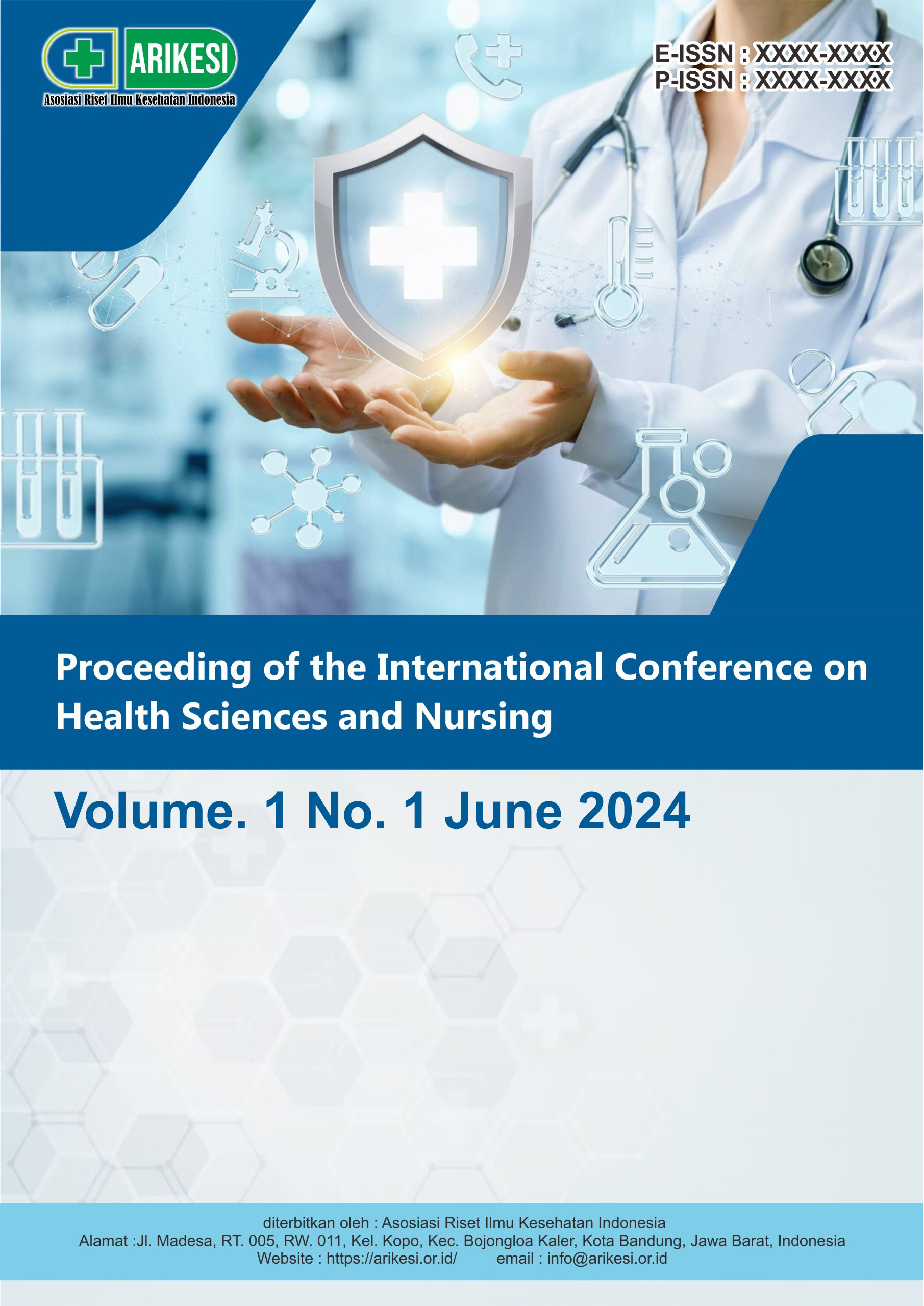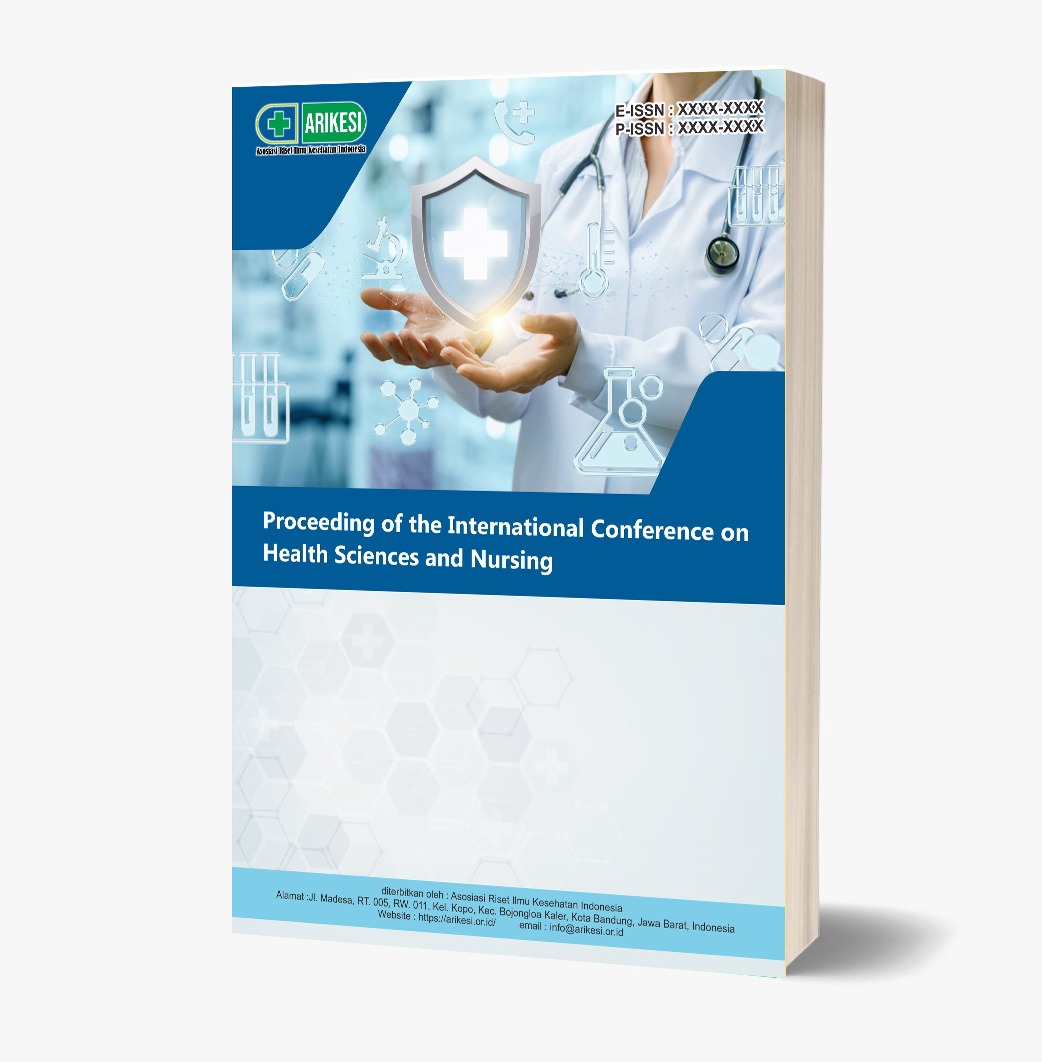Characterization of Yellow Tabebuia Flower Extract (Tabebuia Aurea) Nanoparticles
Keywords:
Tabebuia Aurea, Nanoparticles, Antioxidant ActivityAbstract
Degenerative diseases can be prevented by natural antioxidants in plant. Yellow tabebuia flower is the natural antioxidants. Plant extracts can be developed into green synthesis nanoparticle to increase the effectiveness as medicinal materials. This research aims to determine the characteristics of yellow tabebuia flower extract nanoparticles and bioactivity as antioxidants. The methods included preparation and extraction of simplisia using ethanol solvent by maceration and sonication methods. The extract was determined flavonoid and phenol content by colorimetric method and antioxidant activity by DPPH method. The extract was also made into nano particles by ionic gelation method, with variations in the addition of tween 80 as much as 0.5, 0.75 and 1 ml. The results of this research are extract has a yield 13.09%, contains flavonoids, tannins, phenolics, alkaloids, saponins and terpenoids/steroids. The use of ionic gelation method can reducing particle size. Three formulas made the variation of surfactant addition has a particle size of 47-283 nm, in addition tween 80 1 ml has the smallest particle size of 47 nm with a zeta potential value of 39.3 mV.
Downloads
References
Abdassah, M. (2017). Nanopartikel dengan gelasi ionik. Jurnal Farmaka, 15(1), 45–52.
Andriani, D., Murtisiwi, L. (2018). Penetapan Kadar Fenolik Total Ekstrak Etanol Bunga Telang (Clitoria Ternatea L.) Dengan Spektrofotometri Uv Vis. Cendekia Journal of Pharmacy, 2(1), 32–38. https://doi.org/10.31596/cjp.v2i1.15
Anwar, Z., Hussain, F. (2017). Steroidal Saponins: An Overview of Medicinal Uses. Ijcbs, 11, 20–24. www.iscientific.org/Journal.html
Aryal, S., et al. (2019). Total Phenolic content, Flavonoid content and antioxidant potential of wild vegetables from western Nepal. Plants, 8(4). https://doi.org/10.3390/plants8040096
Ashour, A.S., et al. (2019). A review on saponins from medicinal plants: chemistry, isolation, and determination. Journal of Nanomedicine Research, 7(4), 282–288. https://doi.org/10.15406/jnmr.2019.07.00199
Bansal, M., et al. (2020). Research Journal of Pharmaceutical , Biological and Chemical Sciences Green Synthesis of Gold and Silver Nanoparticles . 6(1710), 1710–1716.
Briones-Labarca, V., Giovagnoli-Vicuña, C., Cañas-Sarazúa, R. (2019). Optimization of extraction yield, flavonoids and lycopene from tomato pulp by high hydrostatic pressure-assisted extraction. In Food Chemistry (Vol. 278). Elsevier Ltd. https://doi.org/10.1016/j.foodchem.2018.11.106
Chiangnoon, R., Samee, W., Uttayarat, P., Jittachai, W., Ruksiriwanich, W., Sommano, S.R., Athikomkulchai, S., Chittasupho, C. (2022). Phytochemical Analysis, Antioxidant, and Wound Healing Activity of Pluchea indica L. (Less) Branch Extract Nanoparticles. Molecules, 27(3). https://doi.org/10.3390/molecules27030635
Cosme, P., Rodríguez, A.B., Espino, J., Garrido, M. (2020). Plant phenolics: Bioavailability as a key determinant of their potential health-promoting applications. Antioxidants, 9(12), 1–20. https://doi.org/10.3390/antiox9121263
Cushnie, T.P.T., Cushnie, B., Lamb, A.J. (2014). Alkaloids: An overview of their antibacterial, antibiotic-enhancing and antivirulence activities. International Journal of Antimicrobial Agents, 44(5), 377–386. https://doi.org/10.1016/j.ijantimicag.2014.06.001
Debiasi, B.W., et al. (2021). Comparison between maceration and ultrasound-assisted extraction of white bracts with flowers of Bougainvillea spectabilis Willd. Scientific Electronic Archives, 14(2), 47. https://doi.org/10.36560/14220211297
El-Hawary, S.S., Taher, M.A., Amin, E., AbouZid, S.F., Mohammed, R. (2021). Genus Tabebuia: A comprehensive review journey from past achievements to future perspectives. Arabian Journal of Chemistry, 14(4), 103046. https://doi.org/10.1016/j.arabjc.2021.103046
Essien, E.R., Atasie, V.N., Nwude, D.O. (2022). Characterisation of ZnO nanoparticles prepared using aqueous leaf extracts of Chromolaena odorata (L.) and Manihot esculenta (Crantz). In South African Journal …. scielo.org.za. http://www.scielo.org.za/scielo.php?pid=S0038-23532022000100014&script=sci_arttext&tlng=es
Fathiah, F., Purwaningsih, I., Suryana, B. (2024). The Flavonoids, Phenolics, and Antioxidant Activity from Ethanol Extract of Fibraurea tinctoria Lour. Jurnal Info Kesehatan, 22(1), 114–123. https://doi.org/10.31965/infokes.vol22.iss1.1210
Febrinda, A.E., Astawan, M., Wresdiyati, T., Yuliana, N.D. (2013). Kapasitas Antioksidan Dan Inhibitor Alfa Glukosidase Ekstrak Umbi Bawang Dayak. Jurnal Teknologi Dan Industri Pangan, 24(2), 161–167. https://doi.org/10.6066/jtip.2013.24.2.161
Ferraz-Filha, Z. S., et al. (2017). Effects of the aqueous extract from Tabebuia roseoalba and phenolic acids on hyperuricemia and inflammation. Evidence-Based Complementary and Alternative Medicine, 2017. https://doi.org/10.1155/2017/2712108
Ferreira-Júnior, J.C., et al. (2015). Isolation of a dihydrobenzofuran lignan, icariside E4, with an antinociceptive effect from Tabebuia roseo-alba (Ridley) Sandwith (Bignoniaceae) bark. Archives of Pharmacal Research, 38(6), 950–956. https://doi.org/10.1007/s12272-014-0468-4
Fitri, D., Kiromah, N. Z. W., & Widiastuti, T. C. (2020). Formulasi Dan Karakterisasi Nanopartikel Ekstrak Etanol Daun Salam (Syzygium polyanthum) Pada Berbagai Variasi Komposisi Kitosan Dengan Metode Gelasi Ionik. JPSCR: Journal of Pharmaceutical Science and Clinical Research, 5(1), 61. https://doi.org/10.20961/jpscr.v5i1.39269
Fitri, D.R., Syafei, D., Sari, C.P. (2021). Karakteristik Nanopartikel Ekstrak Etanol 70% Daun Jarak Pagar (Jatropha Curcas L.) dengan Metode Gelasi Ionik. Jurnal Farmasi Higea, 13(1), 1. https://doi.org/10.52689/higea.v13i1.324
Irfansyah, F.D., Fatimah., Junairiah, J. (2024). SKRINING FITOKIMIA DAN AKTIVITAS ANTIOKSIDAN TIGA JENIS TABEBUYA (Tabebuia spp.). Berita Biologi, 23(1), 49–59. https://doi.org/10.55981/beritabiologi.2024.1668
Ismayana, A., et al. (2017). Sintesis Nanosilika Dari Abu Ketel Industri Gula Dengan Metode Ultrasonikasi Dan Penambahan Surfaktan. Jurnal Teknologi Industri Pertanian, 27(2), 228–234. https://doi.org/10.24961/j.tek.ind.pert.2017.27.2.228
Khandbahale, S.V., et al. (2017). Nanoparticle-A Review. Asian Journal of Research in Pharmaceutical Science, 7(3), 162. https://doi.org/10.5958/2231-5659.2017.00026.1
Malange, K.F., et al. (2019). Tabebuia Aurea decreases hyperalgesia and neuronal injury induced by snake venom. Journal of Ethnopharmacology, 233(December 2018), 131–140. https://doi.org/10.1016/j.jep.2018.12.037
Mohd-Zin, Z., Abdul-Hamid, A., Osman, A. (n.d.). Antioxidative activity of extracts from Mengkudu (Morinda citrifolia L.) root, fruit and leaf. www.elsevier.com/locate/foodchem
Ogbe, R.J., et al. (2015). A Review of Dietary Phytosterols: Their occurences, metabolism and health benefits. A review on dietary phytosterols: Their occurrence, metabolism and health benefits. Pelagia Research Library Asian Journal of Plant Science and Research, 5(4), 10–21. www.pelagiaresearchlibrary.com
Paes, F., et al. (2014). Tabebuia Aurea decreases in fl ammatory , myotoxic and hemorrhagic activities induced by the venom of Bothrops neuwiedi. Journal of Ethnopharmacology, 1–6. https://doi.org/10.1016/j.jep.2014.10.045
Patel, S.S., Savjani, J.K. (2015). Systematic review of plant steroids as potential antiinflammatory agents: Current status and future perspectives. The Journal of Phytopharmacology, 4(2), 121–125. https://doi.org/10.31254/phyto.2015.4212
Purwanto, D., Bahri, S., Ridhay, A. (2017). UJI AKTIVITAS ANTIOKSIDAN EKSTRAK BUAH PURNAJIWA (Kopsia arborea Blume.) DENGAN BERBAGAI PELARUT. Kovalen, 3(1), 24. https://doi.org/10.22487/j24775398.2017.v3.i1.8230
Putri, A.I., Sundaryono, A., Chandra, I.N. (2019). KARAKTERISASI NANOPARTIKEL KITOSAN EKSTRAK DAUN UBIJALAR (Ipomoea batatas L.) MENGGUNAKAN METODE GELASI IONIK. Alotrop, 2(2), 203–207. https://doi.org/10.33369/atp.v2i2.7561
Rahman, M.M., et al. (2015). In vitro antioxidant and free radical scavenging activity of different parts of Tabebuia pallida growing in Bangladesh. BMC Research Notes, 8(1), 1–10. https://doi.org/10.1186/s13104-015-1618-6
Riskesdas, K. (2018). Hasil Utama Riset Kesehata Dasar (RISKESDAS). Journal of Physics A: Mathematical and Theoretical, 44(8), 1–200. https://doi.org/10.1088/1751-8113/44/8/085201
Sanaji, J.B., Krismala, M.S., Liananda, F.R. (2019). Pengaruh Konsentrasi Tween 80 Sebagai Surfaktan Terhadap Karakteristik Fisik Sediaan Nanoemulgel Ibuprofen. IJMS-Indonesian Journal On Medical Science, 6(2), 88–91.
Santos-sánchez, N. F., & Salas-coronado, R. (2019). We are IntechOpen , the world ’ s leading publisher of Open Access books Built by scientists , for scientists TOP 1 % Antioxidant Compounds and. 1.
Sch, K. (2013). Antioxidant Activity and Phytochemical Screening of Crude Endophytes Extracts of Tabebuia argentea Bur . &. 2013(August), 1641–1652.
Shaikh, J.R., Patil, M. (2020). Qualitative tests for preliminary phytochemical screening: An overview. International Journal of Chemical Studies, 8(2), 603–608. https://doi.org/10.22271/chemi.2020.v8.i2i.8834
Sobiyana, P., Manikandan, R., Anburaj, G. (2019). Comparative analysis of the in vitro antioxidant activity of Tabebuia rosea and Tabebuia argentea. ~ 2673 ~ Journal of Pharmacognosy and Phytochemistry, 8(1), 2673–2677.
Susanti, F., et al. (2021). Pengaruh Variasi Waktu Sonikasi Terhadap Kadar Flavonoid Total Ekstrak Metanol Umbi Gadung (Dioscorea hispida Dennst.). Prosiding Seminar Nasional UAD, 1–10.
Teng, H., Chen, L. (2019). Polyphenols and bioavailability: an update. Critical Reviews in Food Science and Nutrition, 59(13), 2040–2051. https://doi.org/10.1080/10408398.2018.1437023
Yunita, Y., Santoso, A., Subandi, S. (2021). Xanthine oxidase inhibitory activity and identification of flavonoid in ethanol extract of sugar apple fruit (Annona squamosa L.). AIP Conference Proceedings, 2353(May). https://doi.org/10.1063/5.0052695







